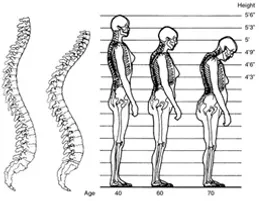
Osteoporosis is a condition that currently affects a large number of people around the world. Approximately 66% of Australians over 50, have osteoporosis or osteopenia. This number is expected to increase over 6 million people by 2022 just in Australia. In addition, it is a costly disease for the Australian Government: 2.75 billion AU$ was spent on osteoporosis or osteopenia in 2012.
However this number of people affected with osteoporosis is not exact, as many people are underdiagnosed and they are not aware of having low bone density. About 75% women and 90% men with an osteoporotic condition are not investigated and around 75% of them are not being treated.
It is a common disease affecting predominantly on the ageing population and the most serious complication is having an osteoporotic fracture. This type of fracture increases as we get older, osteoporosis is the commonest cause of fractures in this population, especially fractures of the wrist, hip, humerus and vertebras. Some fractures may be related to a minimal trauma or no trauma, or it can be related to a fall. For instance, some vertebral fractures can be caused by simple movements like forward bending with the trunk or lifting. Spinal compression fractures can take place suddenly (with or without pain), and it is characterized of height loss (can be up to 4-8 inches) and a significant stooped posture.

Osteoporosis is a disease which affects the quality of the bone tissue. It is characterised by a decrease in bone mass, increased fragility and consequently increasing the risk of fracture.
Bone is a living tissue that reacts to load, mechanical stresses and stimulus (different to the normal habitual load), enhancing bone remodelling and creating new bone formation. Specific exercises can create this mechanical stimulus and promote beneficial effects on bone density.

It is important that you always consult with your doctor for specific osteoporosis medical treatment and preventative treatment to minimize the risk of bone loss and fracture. Vitamin D, calcium and pharmacologic treatment are beneficial and effective treating osteoporosis, but your GP will be involved prescribing the adequate treatment for you.
Different factors may increase the risk of having osteoporosis:
- AGE
- GENES (eg: Family history of fracture)
- MEDICATIONS (eg: diuretic, corticosteroids, anti-convulstants)
- HORMONAL IMBALANCE ( eg: low testosterone, menopause )
- DIET (eg: vitamin D or calcium deficiency, anorexia, alcohol consumption)
- SECONDARY TO OTHER DISEASES ( eg: thyroid, liver, bowel diseases)
- LIFESTYLE ( eg: smoking, sedentary lifestyle)
One of the most common risks for osteoporosis is menopause. It is believed that oestrogen levels alter through menopause, influencing bone tissue demineralization, in fact, since the commencement of menopause there can be an increase of bone loss up to 2- 4% per year.
Physiotherapy and exercise assist in the treatment for osteoporosis. Known benefits include improved quality of life and decreased the risk of falling, consequently reducing the risk of fractures. Even though the evidence about the effects of exercise on the Bone Density Mass seems to provide little improvement (between 2% and 4% increase of BDM depending on studies), specific exercises can prevent further bone loss and can decrease the risk of falling.
At XPhysiotherapy, we are aware that not all kinds of exercises are beneficial for treating osteoporosis. It appears that weight bearing exercises; progressive resistance training and impact exercises have a positive effect on the bone density. On the contrary, exercises that does not include gravitational load (for example swimming) have no significant effects on the bone density. Aerobic exercise alone has been shown not prevent of falling or fracture, so it is necessary to add to your exercise routine balance retraining daily in a safe environment (15 -20 min daily), so you can train your body to react if you lose the balance and therefore prevent a fall.
Expert Panel Board consensus recommendation:

Furthermore, it is important to bear in mind that some type of exercises can be harmful. For example exercises which include excessive spinal flexion movements (eg: sit ups) can increase the risk of damaging the spine. For this reason, having a correct posture during exercise is crucial, maintaining appropriate body alignment throughout exercises and daily activities. It is recommended to consult your physiotherapist or exercise physiologist to prescribe an adequate exercise program and postural advice, according to your past injuries and other medical conditions.
To sum up, osteoporosis is a complex disease influenced by multiple factors and treatment requires a combination pharmacological therapy, adequate diet program and physical activity to provide the best outcomes. Being fitter, stronger, improving balance and reflexes will help you to prevent the consequences of having low bone density and improve your quality of life. We are pleased to now offer a targeted osteoporosis exercise class at XPhysiotherapy. Times will be posted soon.
REFERENCES
- Kelley GA, Kelley KS, Kohrt WM. Exercise and bone mineral density in premenopausal women: a meta-analysis of randomized controlled trials. Int J Endocrinol. 2013;2013:741639.
- Nguyen TV , Jacqueline R Center and John A Eisman (2004) Osteoporosis: underrated, underdiagnosed and undertreated., Medical Journal Australia Med J Aust 180:S18–S22
- Osteoporosis Australia. 2014. www.osteoporosis.org.au. [ONLINE] Available at: http://www.osteoporosis.org.au/sites/default/files/files/oa_consumer_ed2_Aug2014.pdf. [Accessed 3 November 2016].
- Osteoporosis Australia. 2012. www.osteoporosis.org.au. [ONLINE] Available at: http://osteoporosis.org.au/sites/default/files/files/Burden%20of%20Disease%20Analysis%202012-2022.pdf. [Accessed 3 November 2016].
- World Health Organization (1994) Assessment of fracture risk and its application to screening for postmenopausal osteoporosis. WHO Technical Report Series 843. WHO, Geneva
- Sinaki, M., & Mikkelsen, B.A. 1984. Postmenopausal spinal osteoporosis: Flexion versus extension exercises. Archives of Physical Medicine and Rehabilitation, 65 (10), 593-96
- Nikander R, Sievanen H, Heinonen A, et al. Targeted exercise against osteoporosis: a systematic review and metaanalysis for optimising bone strength throughout life. BMC Med 2010; 8: 47
- Howe TE, Shea B, Dawson LJ, Downie F, Murray A, Ross C, Harbour RT, Caldwell LM, Creed G.Exercise for preventing and treating osteoporosis in postmenopausal women.Cochrane Database of Systematic Reviews 2011, Issue 7. Art. No.: CD000333.DOI: 10.1002/14651858.CD000333.pub2.
- Watson SL, Weeks BK, Weis LJ, Horan SA, Beck BR (2015) Heavy resistance training is safe and improves bone, function, and stature in postmenopausal women with low to very low bone mass: novel early findings from the LIFTMOR trial. Osteoporos Int 26(12):2889–94. doi:10.1007/s00198-015-3263-2
- Giangregorio LM, Papaioannou A, Macintyre NJ, Ashe MC,Heinonen A, Shipp K, Wark J, McGill S, Keller H, Jain R,Laprade J, Cheung AM (2014) Too Fit to fracture: exercise recommendations for individuals with osteoporosis or osteoporotic vertebral fracture. Osteoporosis Int 25(3):821–835
- Image http://medical-dictionary.thefreedictionary.com/osteoporosis
- Image http://www.healthelective.ca/wp-content/uploads/2013/04/172853.jpg

